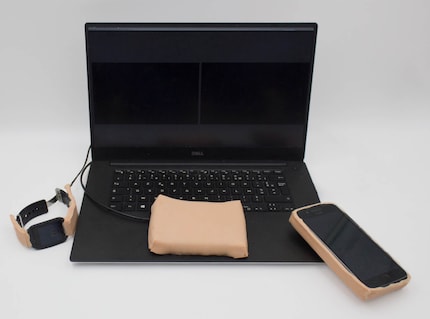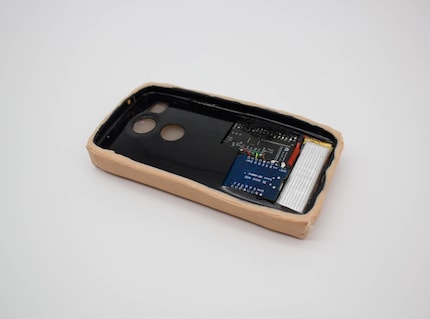Skin-On Interfaces
Which do you prefer?
- Adding devices to the human or...73%
- ...the device the people?27%
The competition has ended.

Hardware is not only becoming softer, but also more human: "skin-on interfaces" give your smartphone or joystick an artificial skin.
In my series "When hardware goes soft", I wrote about the fact that contemporary product design has a mission: To make hardware more pleasant and natural. Now that buttons are exotic because they've been replaced by cool touchscreens, designers are looking for new ways to stimulate our sense of touch. After the soft Kvadrat fabric that wraps your speaker, there's now an even more sensual cover for your devices: an artificial skin that looks just like a human skin.
Yes, you're reading correctly. It sounds bizarre, but "skin-on interfaces" are skin-like input methods that can be added to existing devices to improve their functions. They were developed as part of a research project by the Bristol Interaction Group, in which designer Marc Teyssier played a key role. "The human skin is the best interface for interaction," explains the HCI researcher and interaction designer. "I propose this new paradigm in which interactive devices have their own artificial skin and thus enable new forms of input gestures for end users." So you can not only touch your smartphone, but even pinch it to give commands.
The prototypes are inspired by human skin. They consist of several layers. The top layer is peach-coloured and has deceptively real-looking wrinkles and lines that imitate veins. Underneath the layers are the same electrodes that are found in a smartphone touchscreen. They react when you touch - or tickle - the surface because they measure pinches and twists. "The fabrication process is fairly simple and can be easily replicated by other researchers and HCI practitioners," Teyssier says. That's why he shares the construction of the silicone skin publicly on his website.


The strange design questions the relationship between man and machine. Looking at the video, I wrinkle my nose, but I have to admit that I would love to test such a device with a skin-on interface. Just switching from a wallet hard case to a silicone case improved the handling of my smartphone back then. I find the surface a lot softer and easier to grip. What would a skin-on interface feel like then?
Which do you prefer?
The competition has ended.
Like a cheerleader, I love celebrating good design and bringing you closer to everything furniture- and interior design- related. I regularly curate simple yet sophisticated interior ideas, report on trends and interview creative minds about their work.
From the latest iPhone to the return of 80s fashion. The editorial team will help you make sense of it all.
Show all